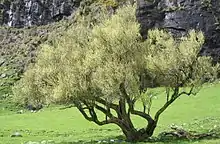Stathmopoda albimaculata
Stathmopoda albimaculata is a species of moth in the Stathmopodidae family. It is endemic to New Zealand and is located in the lower half of the South Island. This species favours habitat that includes the various Olearia species that host its larvae. It has also been found to inhabit lowland podocarp native forest. The larvae feed on species in the genus Olearia. Adults are on the wing between the months of October and February. S. albimaculata is classified as Nationally Endangered by the Department of Conservation.
| Stathmopoda albimaculata | |
|---|---|
 | |
| Female holotype specimen held at Auckland Museum | |
| Scientific classification | |
| Domain: | Eukaryota |
| Kingdom: | Animalia |
| Phylum: | Arthropoda |
| Class: | Insecta |
| Order: | Lepidoptera |
| Family: | Stathmopodidae |
| Genus: | Stathmopoda |
| Species: | S. albimaculata |
| Binomial name | |
| Stathmopoda albimaculata | |
Taxonomy
S. albimaculata was described by Alfred Philpott in 1931.[3][4] Philpott used a female moth collected by Charles E. Clarke at Woodside, Taieri in December.[4] This holotype specimen is held at the Auckland War Memorial Museum.[5] George Vernon Hudson also used this specimen to describe and figure the species in his 1939 publication A supplement to the butterflies and moths of New Zealand.[6]
Description
.jpg.webp)
Philpott described this species as follows:
♂. 15 mm. Head, palpi and thorax grey mixed with fuscous. Antennae greyish fuscous. Abdomen grey mixed with fuscous and ochreous. Legs fuscous, whorls of spines on posterior pair white. Forewings with costa almost straight, subsinuate, apex rounded, termen extremely oblique; dull greyish fuscous, a little darker on and below fold; an irregular white blotch below fold towards base; a similar blotch near apex: fringes greyish fuscous round apex dark fuscous. Hindwings and fringes greyish fuscous.[4]
Distribution
It is endemic to New Zealand.[2] As well as being collected at Taieri, this species has also been found in central and western Otago, The Catlins, Southland, and the Waitaki Valley.[7]
Habitat and ecology
This species inhabits areas from 50m up to 900m in elevation.[7] Along with habitat that includes the various Olearia species that host S. albimaculata, this moth has also been found to inhabit lowland podocarp/hardwood forest.[8] Adult moths are on the wing between the months of October and February.[7] They are most common in January and February.[7]
Host plants

The species is associated with the nationally endangered plant Olearia hectorii,[9] as well as Olearia odorata and Olearia virgata.[7]
Conservation status
S. albimaculata has been classified under the New Zealand Threat Classification system as being Nationally Endangered.[1]
References
- Hoare, R.J.B.; Dugdale, J.S.; Edwards, E.D.; Gibbs, G.W.; Patrick, B.H.; Hitchmough, R.A.; Rolfe, J.R. (2017). Conservation status of New Zealand butterflies and moths (Lepidoptera), 2015 (PDF). Wellington, New Zealand: New Zealand Department of Conservation. p. 6. ISBN 9781988514383.
- "Stathmopoda albimaculata Philpott, 1931". www.nzor.org.nz. Landcare Research New Zealand Ltd. Retrieved 2 May 2018.
- John Stewart Dugdale (23 September 1988). "Lepidoptera - annotated catalogue, and keys to family-group taxa". Fauna of New Zealand. Department of Scientific and Industrial Research. 14: 108. doi:10.7931/J2/FNZ.14. ISSN 0111-5383. Wikidata Q45083134.
- Philpott, Alfred (1931). "Notes and descriptions of New Zealand Lepidoptera". Transactions and Proceedings of the New Zealand Institute. 62: 26–36.
- "Stathmopoda albimaculata". Auckland War Memorial Museum. Retrieved 2 May 2018.
- Hudson, George Vernon (1939). A supplement to the butterflies and moths of New Zealand. Wellington: Ferguson & Osborn Ltd. p. 456.
- Patrick, B. H. (2000). Lepidoptera of small-leaved divaricating Olearia in New Zealand and their conservation priority (PDF). Wellington, N.Z.: New Zealand Department of Conservation. p. 21. ISBN 0478220154. OCLC 48661253.
- Scott Hooson (2 September 2014). Christchurch District Plan Site of Ecological Significance: Breitmeyers (PDF) (Report). Christchurch City Council. pp. 1–17. Retrieved 2 May 2018.
- Mt Aspiring Station Conservation Resources Report Part 1 (Report). Department of Conservation. November 2005. pp. 1–62. Retrieved 2 May 2018.
